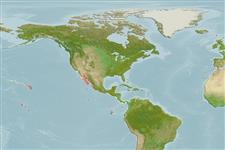分类 / Names
俗名 | 同种异名 | Catalog of Fishes(属, 种) | ITIS | CoL | WoRMS | Cloffa
Teleostei >
Blenniiformes (Blennies) >
Labrisomidae (Labrisomids)
Etymology: Malacoctenus: Greek, malakos = soft + Greek, kteis, ktenos = comb (Ref. 45335).
Eponymy: Dr Clark Hubbs (1921–2008) was an ichthyologist and biologist who followed in his father’s footsteps (see Carl Levitt Hubbs, below). [...] (Ref. 128868), visit book page.
Environment: milieu / climate zone / depth range / distribution range
生态学
海洋 居于水底的; 深度上下限 1 - 4 m (Ref. 11482). 熱帶
Eastern Central Pacific: Gulf of California and southwestern coast of Baja California.
中太平洋東部: 下加利福尼亞與加州灣到墨西哥的亞嘉普科。
大小 / 重量 / 年龄
Maturity: Lm ? range ? - ? cm
Max length : 9.0 cm TL 雄鱼/尚未辨别雌雄; (Ref. 11482)
Malacoctenus hubbsi differs from Malacoctenus polyporosus by the following characters: symphysial pores 1-3, usually 1 or 3 (vs. 2-10 usually 5-7); lateral line scales 51-61, usually 54-58 (vs. 49-56, usually 50-53); and by the number of anal-fin rays (Ref. 82814).
Occurs in shallow rocky areas. Feeds on invertebrates.
出现于水浅的岩石区。 吃无脊椎动物。
Life cycle and mating behavior
成熟度 | 繁殖 | 产卵场 | 卵 | 孕卵数 | 仔鱼
中太平洋東部: 下加利福尼亞與加州灣到墨西哥的亞嘉普科。
Allen, G.R. and D.R. Robertson, 1994. Fishes of the tropical eastern Pacific. University of Hawaii Press, Honolulu. 332 p. (Ref. 11482)
世界自然保护联盟红皮书 (Ref. 130435: Version 2024-1)
人类利用
工具
特别资料
下载 XML
网络资源
Estimates based on models
Preferred temperature (Ref.
123201): 22.3 - 28.5, mean 24.4 °C (based on 123 cells).
Phylogenetic diversity index (Ref.
82804): PD
50 = 0.5000 [Uniqueness, from 0.5 = low to 2.0 = high].
Bayesian length-weight: a=0.00955 (0.00474 - 0.01922), b=3.10 (2.93 - 3.27), in cm total length, based on LWR estimates for this species & (Sub)family-body (Ref.
93245).
营养阶层 (Ref.
69278): 3.5 ±0.37 se; based on food items.
Fishing Vulnerability (Ref.
59153): Low vulnerability (10 of 100).
Nutrients (Ref.
124155): Calcium = 363 [197, 826] mg/100g; Iron = 1.52 [0.91, 2.81] mg/100g; Protein = 18.1 [17.1, 19.1] %; Omega3 = 0.216 [0.114, 0.400] g/100g; Selenium = 22.4 [10.7, 50.9] μg/100g; VitaminA = 50.9 [15.5, 163.4] μg/100g; Zinc = 2.19 [1.49, 3.32] mg/100g (wet weight);
